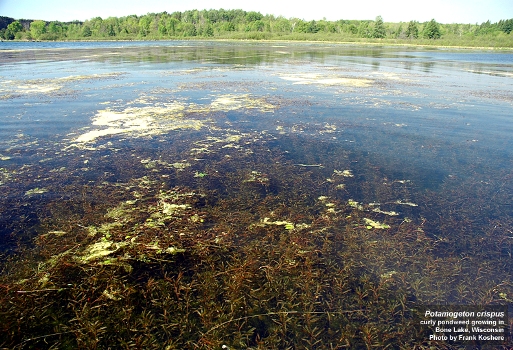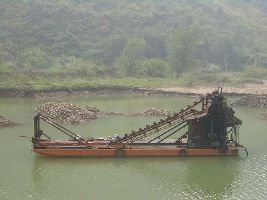Controlling a killer (Ecological Management)
 Curly leaf pondweed is well-adapted to be an invasive species
(if you've forgotten, check out the
ADAPTATIONS page to refresh your memory)! Although it was
originally introduced to the United States as an aquarium plant
and duck food (it was originally planted in Michigan lakes as a
food source for ducks), it can now be found in almost every
state of the US as well as in New Zealand, Europe, and Africa.
In fact, curly leaf pondweed is actually a pretty popular
organism; it has made headlines across the world as an invasive
species! Read more about thes
Curly leaf pondweed is well-adapted to be an invasive species
(if you've forgotten, check out the
ADAPTATIONS page to refresh your memory)! Although it was
originally introduced to the United States as an aquarium plant
and duck food (it was originally planted in Michigan lakes as a
food source for ducks), it can now be found in almost every
state of the US as well as in New Zealand, Europe, and Africa.
In fact, curly leaf pondweed is actually a pretty popular
organism; it has made headlines across the world as an invasive
species! Read more about thes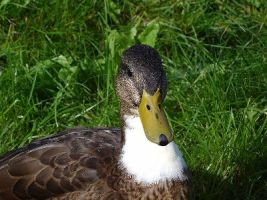 e invasions in the
Winnipeg Press of North Dakota, the
Journal Gazette of Fort Wayne, Indiana, the
Eden Prairie News in Minnesota,
WEAU of Eau Claire, Wisconsin, and in the
Star Tribune of Minneapolis! Curly leaf pondweed was also
put on a "black list" of invasive species in Britain (THAT
article can be found by clicking
HERE)!
e invasions in the
Winnipeg Press of North Dakota, the
Journal Gazette of Fort Wayne, Indiana, the
Eden Prairie News in Minnesota,
WEAU of Eau Claire, Wisconsin, and in the
Star Tribune of Minneapolis! Curly leaf pondweed was also
put on a "black list" of invasive species in Britain (THAT
article can be found by clicking
HERE)!
Because this plant is SO successful at taking over native submerged-plant communities, curly leaf pondweed is considered extremely harmful. Its early growth and quick maturity often block sunlight for other native species and its early die-off leaves mats of decomposing curly leaf pondweed on the surface of the lake. As these plants break down, they add phosphorus and other nutrients to the water. The addition of these nutrients dramatically increase the potential for algal blooms within the lake!
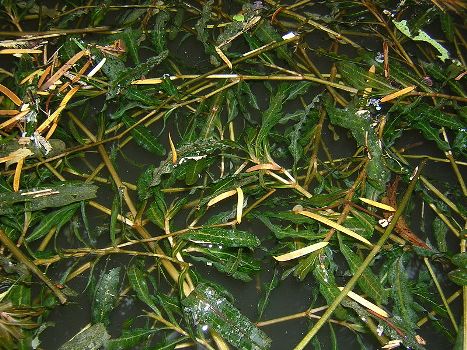 So what can be done to stop the inevitable
madness of this submerged macrophyte monster? Early
methods of controlling this invasive species include
hand-pulling the weeds and the prevention of
spreading fragments. Often times, pieces of curly
leaf pondweed attached to a boat or trailer often
fall near boat launches where there is little
competition. Efforts to prevent this spread may help
to stop curly leaf from taking over many more lakes
across the world!
So what can be done to stop the inevitable
madness of this submerged macrophyte monster? Early
methods of controlling this invasive species include
hand-pulling the weeds and the prevention of
spreading fragments. Often times, pieces of curly
leaf pondweed attached to a boat or trailer often
fall near boat launches where there is little
competition. Efforts to prevent this spread may help
to stop curly leaf from taking over many more lakes
across the world!
Once curly leaf pondweed has become an
established community within a particular ecosystem,
herbicidal
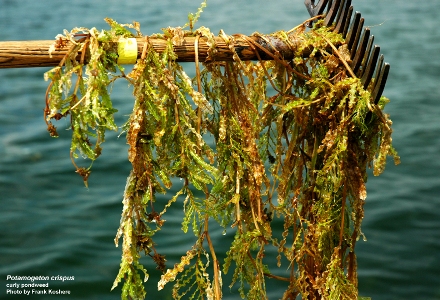 treatments are often used to eradicate
the species entirely! Before this is done, a lake
management plan, which includes the mapping of curly
leaf pondweed populations and other environmental
factors, is performed to determine how long the
treatment should be given to the lake. This is a
risky procedure as these herbicides often hurt other
aquatic plant life besides the devious
Potamogeton crispus. Often times, certain parts
of lakes are quarantined to avoid the spread of
curly leaf pondweed. These areas are often marked or
mapped out by local or state regulators like the
DNR.
treatments are often used to eradicate
the species entirely! Before this is done, a lake
management plan, which includes the mapping of curly
leaf pondweed populations and other environmental
factors, is performed to determine how long the
treatment should be given to the lake. This is a
risky procedure as these herbicides often hurt other
aquatic plant life besides the devious
Potamogeton crispus. Often times, certain parts
of lakes are quarantined to avoid the spread of
curly leaf pondweed. These areas are often marked or
mapped out by local or state regulators like the
DNR.
Other techniques to rid an ecosystem of curly
leaf pondweed include dredging (pictured to the
right), drawdown, and
benthic barriers. Dredging is often used in lakes
that have been filled with sediments
or the removal
of certain toxic substances. This is an expensive
technique and is often used on lakes that are in
need of aquatic plant management AND lake
remediation. Drawdown is a form of management that
involves removing water to a certain depth. It is
most effective if used for at least one month.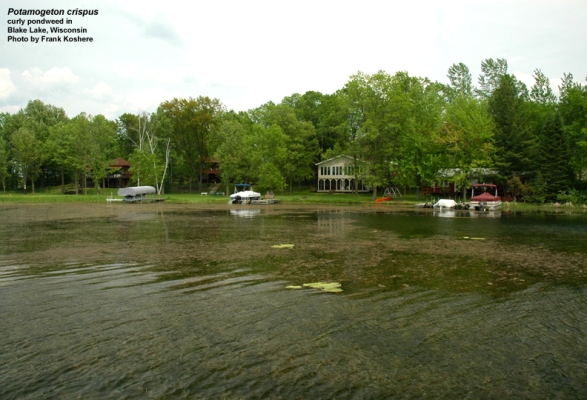 Although this method is inexpensive, it can have harmful long-term effects on other populations of
plants and animals that live in the ecosystem.
Benthic barriers cover a layer of the submerged
plant to prevent them from growing. Eventually, new
plants will grow on top of this barrier. Occasionally gasses from the decomposing plants
underneath the barrier force the barrier off of the
layer of plants. Talk about resistance!
Although this method is inexpensive, it can have harmful long-term effects on other populations of
plants and animals that live in the ecosystem.
Benthic barriers cover a layer of the submerged
plant to prevent them from growing. Eventually, new
plants will grow on top of this barrier. Occasionally gasses from the decomposing plants
underneath the barrier force the barrier off of the
layer of plants. Talk about resistance!
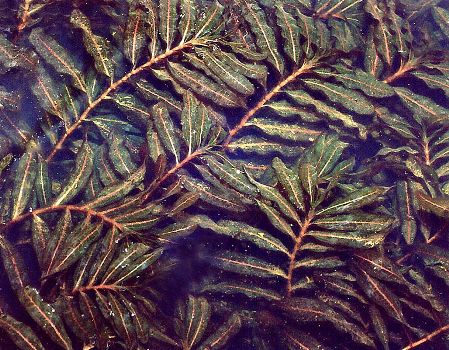 It's important to educate people about how curly
leaf pondweed spreads through lake communities. Once
a
population
of this invasive species has been removed from the
environment, it's crucial to inform local
communities about how to keep this plant out!
It's important to educate people about how curly
leaf pondweed spreads through lake communities. Once
a
population
of this invasive species has been removed from the
environment, it's crucial to inform local
communities about how to keep this plant out!
Many states in the United States offer special plans to prevent the spread of curly leaf pondweed within their lakes. In the Midwest, the Wisconsin DNR offers guidance for dealing with many invasive species (which can be found by clicking HERE). Minnesota offers a specialized pamphlet for the treatment of curly leaf pondweed (check it out)!.
Who would've guessed this plant was such a nuisance?
What do YOU think of when you hear the word pupuke? Continue on to FACTS to discover what this strange word actually means!
